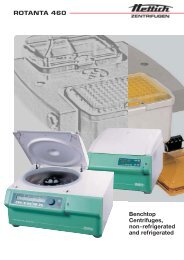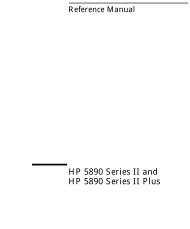HP 5890 Series I and Series II Reference Manual (05890 ... - Ipes.us
HP 5890 Series I and Series II Reference Manual (05890 ... - Ipes.us
HP 5890 Series I and Series II Reference Manual (05890 ... - Ipes.us
Create successful ePaper yourself
Turn your PDF publications into a flip-book with our unique Google optimized e-Paper software.
Chromatographic Troubleshooting<br />
Baseline symptoms<br />
� Contaminated detector gases (hydrogen <strong>and</strong> air).<br />
� Air currents from a fan or air conditioner blowing across the top of<br />
the instrument may interfere with gas exiting from the detector.<br />
This is a possible, though not very likely, ca<strong>us</strong>e of noise since<br />
detectors are well protected. Switching off the air current source<br />
or shielding the detector area identifies this problem.<br />
� An inadequately tightened collector on an FID or NPD generates<br />
noise.<br />
� A contaminated detector results in noise.<br />
2. Noise increases gradually to an unacceptable level:<br />
� This symptom indicates gradual buildup of the noise source,<br />
rather than an abrupt change as disc<strong>us</strong>sed above. FI detectors are<br />
s<strong>us</strong>ceptible to gradual buildup of deposits in the collector. In<br />
extreme cases spiking occurs along with increased noise level.<br />
Silicon dioxide deposits are formed when bleed from a silicone<br />
column is burned in the flame. This material is removed<br />
mechanically. Preventive measures include <strong>us</strong>e of low column<br />
loadings, stationary phases with high•temperaturelimit, thorough<br />
column conditioning before <strong>us</strong>e, <strong>and</strong> the lowest possible oven<br />
temperatures for the analysis.<br />
� Carbon deposits may form from solvents that burn poorly<br />
(primarily chlorinated materials <strong>and</strong> aromatics). If possible, avoid<br />
such solvents. If they are necessary, periodic cleaning of the<br />
collector is required.<br />
� Gradual noise increase may occur from saturated carrier gas drier<br />
or chemical traps. When these approach their capacities,<br />
contaminants begin to pass through <strong>and</strong> create noise. Trap <strong>and</strong><br />
drier regeneration or replacement eliminates this source of noise.<br />
205




